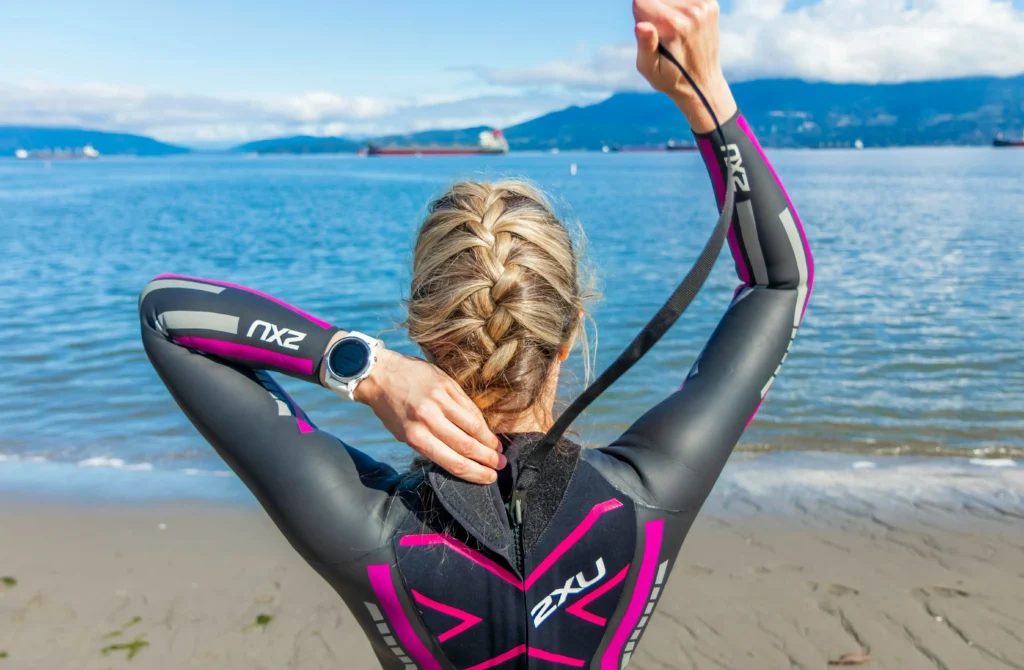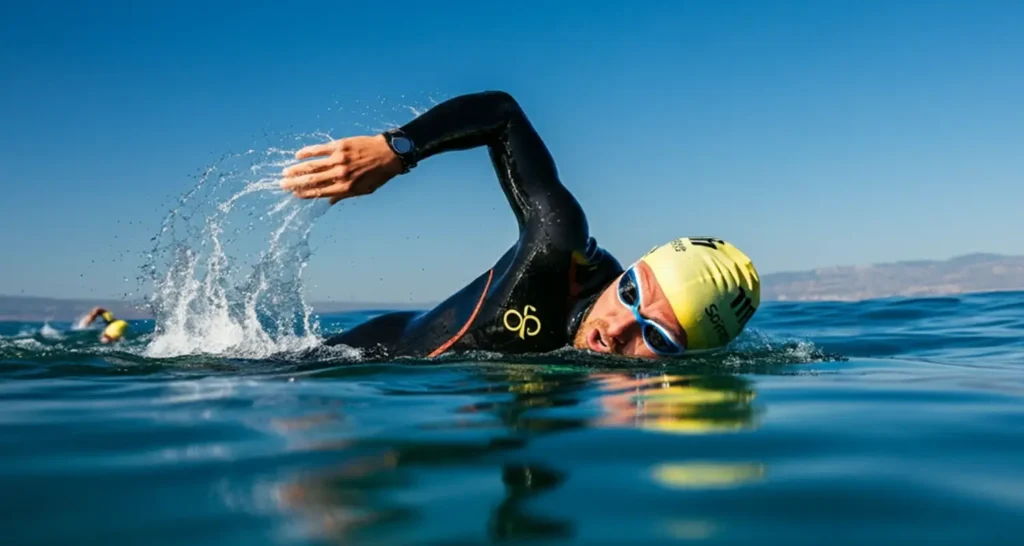
Why Most Triathletes Fail the Swim (And How to Avoid It)
Open water swimming technique accounts for 10-15% of DNFs in triathlons—not due to fitness, but poor technique adaptation. While pools teach clean strokes, race day throws chaos: 360° navigation, jellyfish encounters, and panic-inducing “washing machine” starts. This guide merges hydrodynamics research, pro triathlete strategies, and survival psychology to transform your swim from liability to asset.
Why Your Pool Times Lie: 5 Open Water Shockers
- Wave Drag Costs 38% More Energy (Source: Journal of Sports Sciences): Chop forces a shorter, faster stroke.
- Poor Sighting Adds 15% Distance: Swimming 1,500m? You might log 1,725m.
- Wetsuits Aren’t Magic: 70% of age-groupers wear them wrong—over-rotating shoulders.
- Drafting Cuts Effort by 21% (Source: Triathlon Research Study, 2022): But only if positioned within 30cm.
- Cold Water = 12% Slower Split: Vasoconstriction saps power unless you acclimate.
Body Position: The Wetsuit Trap Most Swimmers Fall Into
Problem: Wetsuits lift hips but sink shoulders if you over-rotate.
Fix:
- Rotate shoulders 50° (not 30° pool rotation) to slice through waves.
- Drill: “Weightless Shoulders” (Video embedded below): Swim 4x50m focusing on “pushing” your wetsuit buoyancy down to hips.
Pro Tip: Coach Emma Snowsill (3x World Champion) says: “If your neck chafes, your head’s too high. Eyes should ‘map’ the seabed, not the horizon.”
Sighting: A Navy SEAL’s Navigation Trick
Standard Advice: “Sight every 6 strokes.”
SEAL-Level Upgrade:
- Sun Glare: Spot buoy shadows instead of colors.
- Crowded Waters: Align with a taller competitor’s stroke rhythm between sights.
- Drill: “Target Acquisition” (Video embedded): Swim zigzags while partner randomly holds up colored paddles—identify color mid-stroke.
Case Study: Triathlete Jake McEwan cut 47 seconds by switching to “shadow sighting” at Ironman NZ.
Drafting: The Legal Cheat Code
Optimal Zones:
- Feet Draft: 0.3m behind toes (18% energy saved).
- Hip Draft: Parallel to leader’s hips (12% savings, better visibility).
Turbulence Science: Stay within the leader’s “slipstream cone” (45° angle from their hips).
Drill: “Drafting Roulette”: In groups of 3, rotate leaders every 100m. Learn to adjust pace without breaking form. Here is the average time for triathletes in T100 competition.
Anxiety Fix: The 10-Second Iceberg Drill
Pre-Race:
- 5-4-3-2-1 Grounding: Name 5 sights, 4 sounds, 3 sensations pre-race.
Mid-Panic: - Iceberg Technique: Flip to back, exhale for 10 seconds (lowers heart rate via mammalian dive reflex).
Pro Quote: Dr. Laura Lewis, Sports Psychologist: “Anxiety peaks at 90 seconds. Survive that, and cortisol drops 60%.”
Wetsuit Hacks You’ve Never Heard
- Neck Gap Test: Slide two fingers under neck seal—prevents choking.
- Armpit Wrinkles = Drag: Use body glide on inner arms.
- Exit Rehearsal: Practice stripping while running uphill 10x pre-race.
Sample Workout: “Race Chaos Simulator”
Warm-Up:
- 400m easy + 8x25m Tarzan Drill (sighting every 3 strokes).
Main Set:
- “Mass Start Madness”: 10x100m in groups of 5, sprinting to “breakaway” at 75m.
- “Blind Turns”: Partner redirects you mid-lap using a pool noodle tap.
Cool-Down:
- 200m backstroke + 5min iceberg breathing.
Conclusion: Transform Your Triathlon Swim From Liability to Advantage
Open water swimming technique isn’t about brute strength—it’s a chess match of precision. Master these techniques, and you’ll not only survive the chaos but thrive in it. Remember:
- Sighting is strategy: Spot shadows, not buoys, and let taller competitors navigate for you.
- Drafting is free speed: Position yourself in the slipstream cone, not just blindly following feet.
- Anxiety is optional: Use the Iceberg Drill to reset your nervous system mid-panic.
As 3x Ironman Champion Chrissie Wellington says, “The swim isn’t the first leg—it’s the first test. Pass it calmly, and the bike/run become a victory lap.”
FAQ: Triathletes’ Top 5 Swim Fears
Use the “Cough-Stroke” (cough into armpit mid-stroke to hide weakness from competitors).
No—25% intensity preserves heat. Over-kicking drains legs and increases hypothermia risk.


Pingback: The Ultimate Guide to Half Ironman Swim Cut Off Times - besttriathletes.com